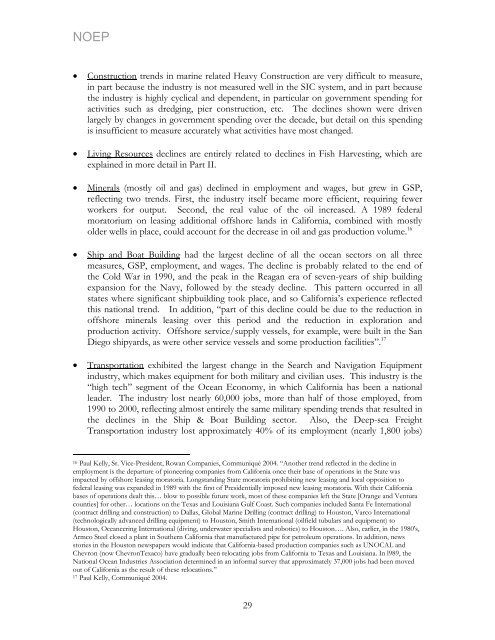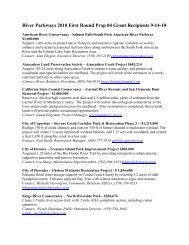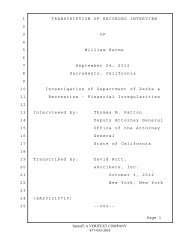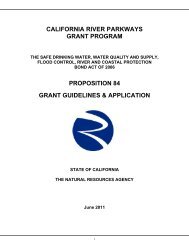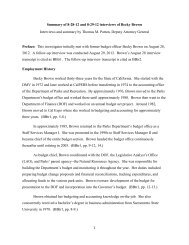California's Ocean Economy - California Resources Agency - State ...
California's Ocean Economy - California Resources Agency - State ...
California's Ocean Economy - California Resources Agency - State ...
Create successful ePaper yourself
Turn your PDF publications into a flip-book with our unique Google optimized e-Paper software.
NOEP<br />
• Construction trends in marine related Heavy Construction are very difficult to measure,<br />
in part because the industry is not measured well in the SIC system, and in part because<br />
the industry is highly cyclical and dependent, in particular on government spending for<br />
activities such as dredging, pier construction, etc. The declines shown were driven<br />
largely by changes in government spending over the decade, but detail on this spending<br />
is insufficient to measure accurately what activities have most changed.<br />
• Living <strong>Resources</strong> declines are entirely related to declines in Fish Harvesting, which are<br />
explained in more detail in Part II.<br />
• Minerals (mostly oil and gas) declined in employment and wages, but grew in GSP,<br />
reflecting two trends. First, the industry itself became more efficient, requiring fewer<br />
workers for output. Second, the real value of the oil increased. A 1989 federal<br />
moratorium on leasing additional offshore lands in <strong>California</strong>, combined with mostly<br />
older wells in place, could account for the decrease in oil and gas production volume. 16<br />
• Ship and Boat Building had the largest decline of all the ocean sectors on all three<br />
measures, GSP, employment, and wages. The decline is probably related to the end of<br />
the Cold War in 1990, and the peak in the Reagan era of seven-years of ship building<br />
expansion for the Navy, followed by the steady decline. This pattern occurred in all<br />
states where significant shipbuilding took place, and so <strong>California</strong>’s experience reflected<br />
this national trend. In addition, “part of this decline could be due to the reduction in<br />
offshore minerals leasing over this period and the reduction in exploration and<br />
production activity. Offshore service/supply vessels, for example, were built in the San<br />
Diego shipyards, as were other service vessels and some production facilities”. 17<br />
• Transportation exhibited the largest change in the Search and Navigation Equipment<br />
industry, which makes equipment for both military and civilian uses. This industry is the<br />
“high tech” segment of the <strong>Ocean</strong> <strong>Economy</strong>, in which <strong>California</strong> has been a national<br />
leader. The industry lost nearly 60,000 jobs, more than half of those employed, from<br />
1990 to 2000, reflecting almost entirely the same military spending trends that resulted in<br />
the declines in the Ship & Boat Building sector. Also, the Deep-sea Freight<br />
Transportation industry lost approximately 40% of its employment (nearly 1,800 jobs)<br />
16 Paul Kelly, Sr. Vice-President, Rowan Companies, Communiqué 2004. “Another trend reflected in the decline in<br />
employment is the departure of pioneering companies from <strong>California</strong> once their base of operations in the <strong>State</strong> was<br />
impacted by offshore leasing moratoria. Longstanding <strong>State</strong> moratoria prohibiting new leasing and local opposition to<br />
federal leasing was expanded in 1989 with the first of Presidentially imposed new leasing moratoria. With their <strong>California</strong><br />
bases of operations dealt this… blow to possible future work, most of these companies left the <strong>State</strong> [Orange and Ventura<br />
counties] for other… locations on the Texas and Louisiana Gulf Coast. Such companies included Santa Fe International<br />
(contract drilling and construction) to Dallas, Global Marine Drilling (contract drilling) to Houston, Varco International<br />
(technologically advanced drilling equipment) to Houston, Smith International (oilfield tubulars and equipment) to<br />
Houston, <strong>Ocean</strong>eering International (diving, underwater specialists and robotics) to Houston…. Also, earlier, in the 1980's,<br />
Armco Steel closed a plant in Southern <strong>California</strong> that manufactured pipe for petroleum operations. In addition, news<br />
stories in the Houston newspapers would indicate that <strong>California</strong>-based production companies such as UNOCAL and<br />
Chevron (now ChevronTexaco) have gradually been relocating jobs from <strong>California</strong> to Texas and Louisiana. In l989, the<br />
National <strong>Ocean</strong> Industries Association determined in an informal survey that approximately 37,000 jobs had been moved<br />
out of <strong>California</strong> as the result of these relocations.”<br />
17 Paul Kelly, Communiqué 2004.<br />
29


